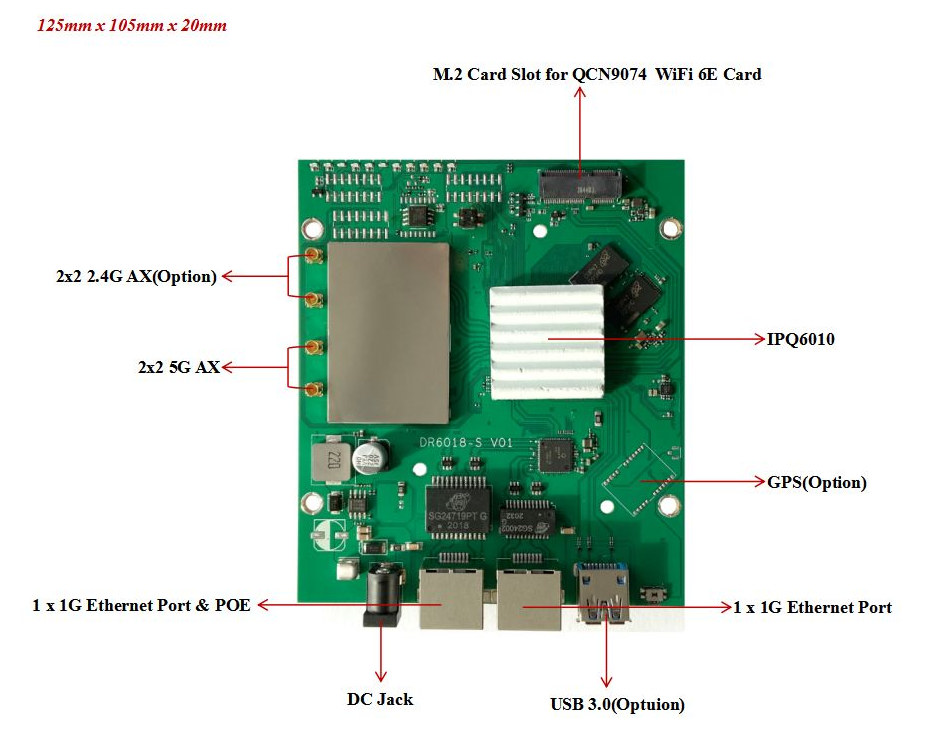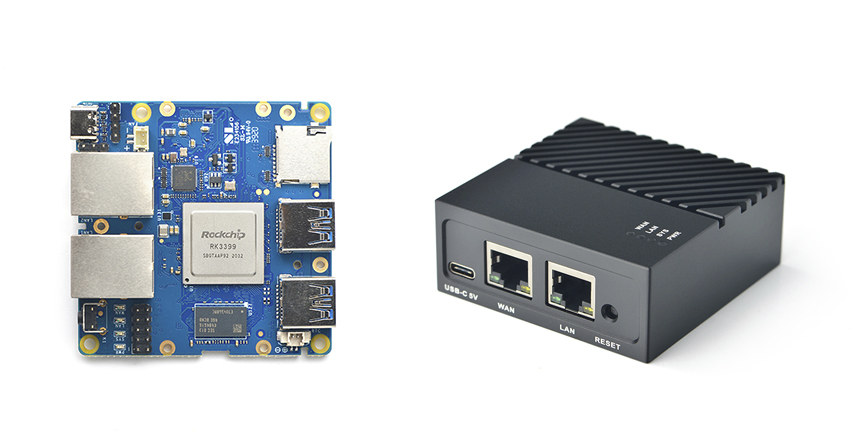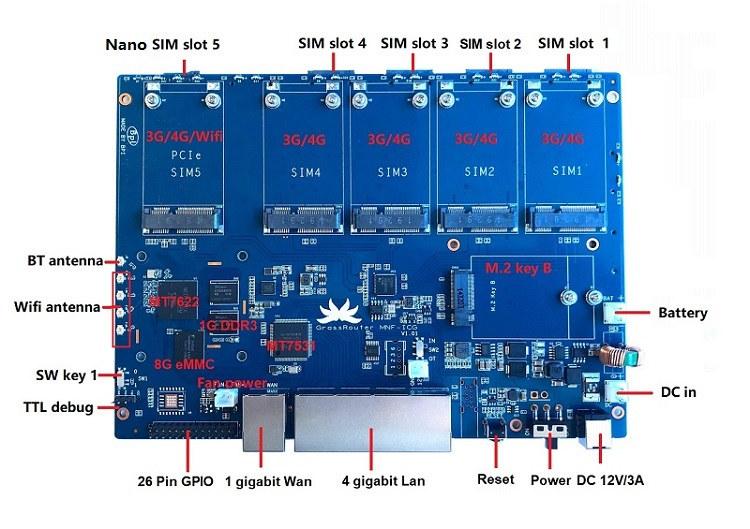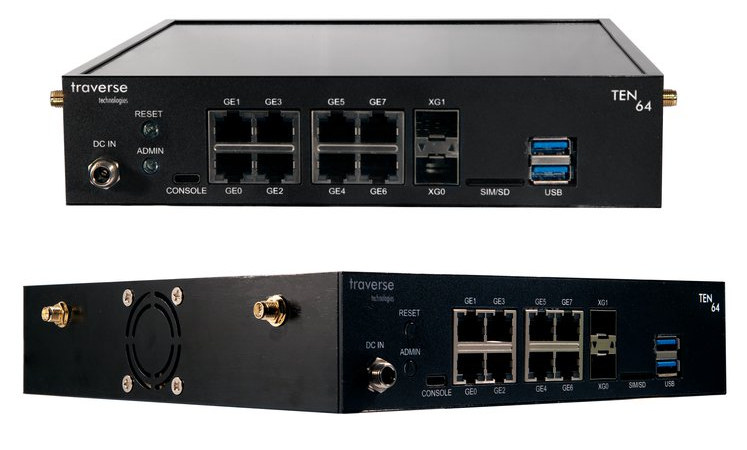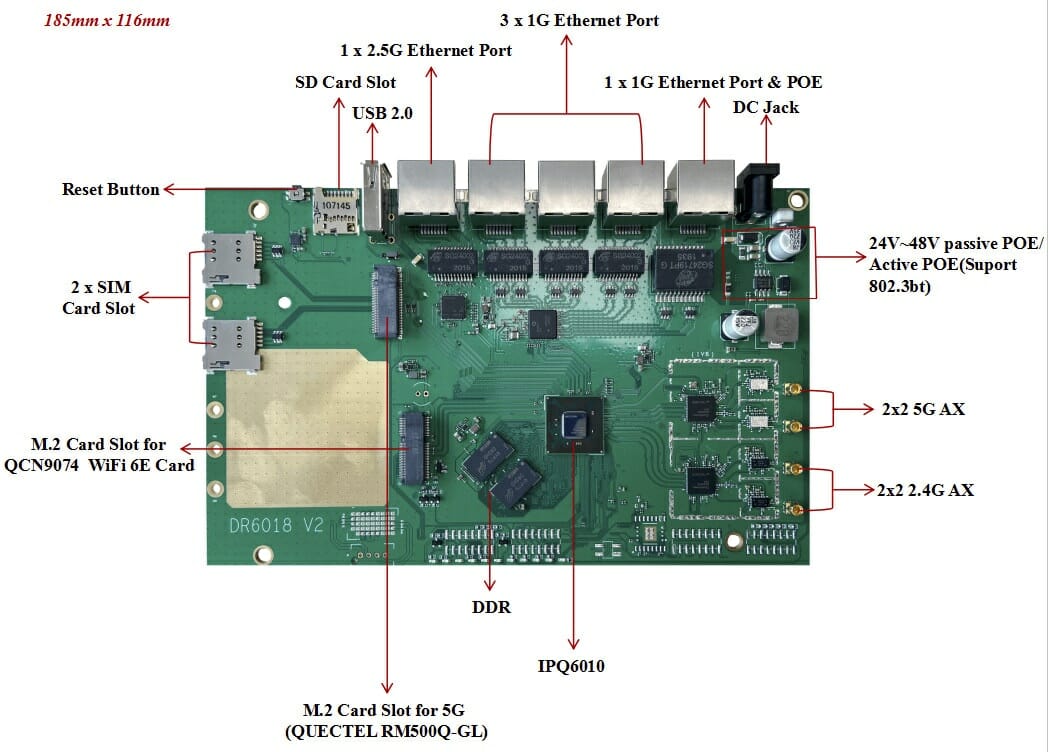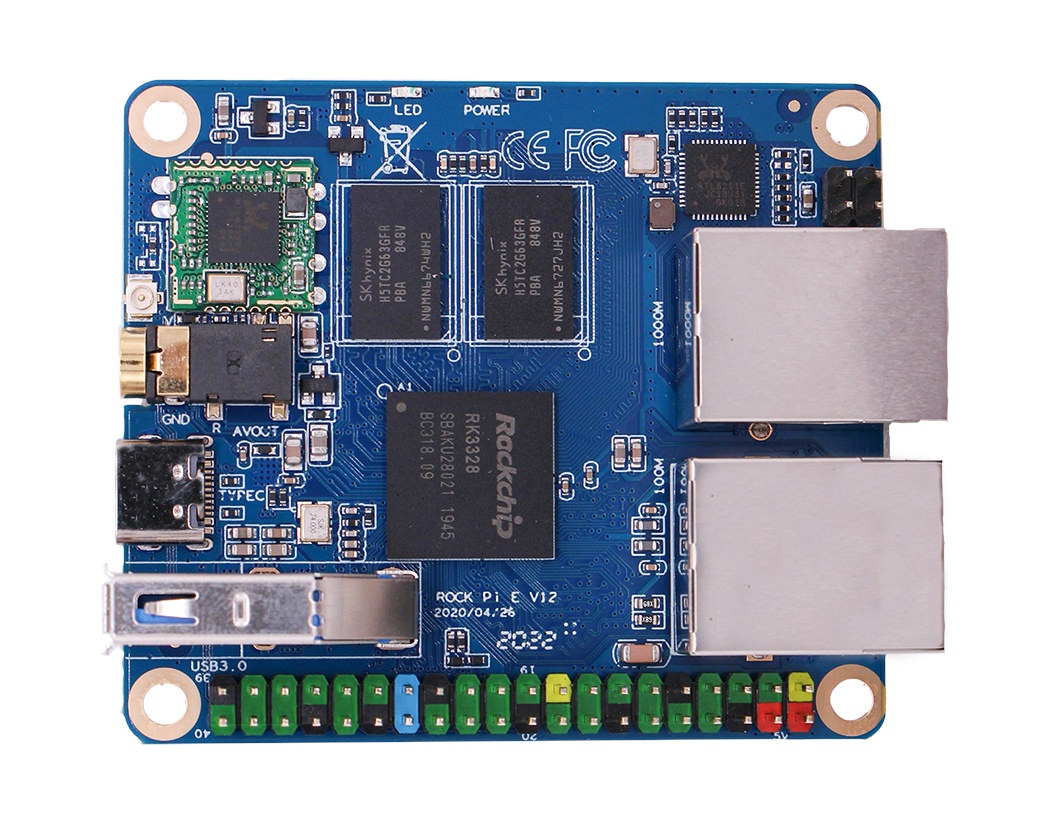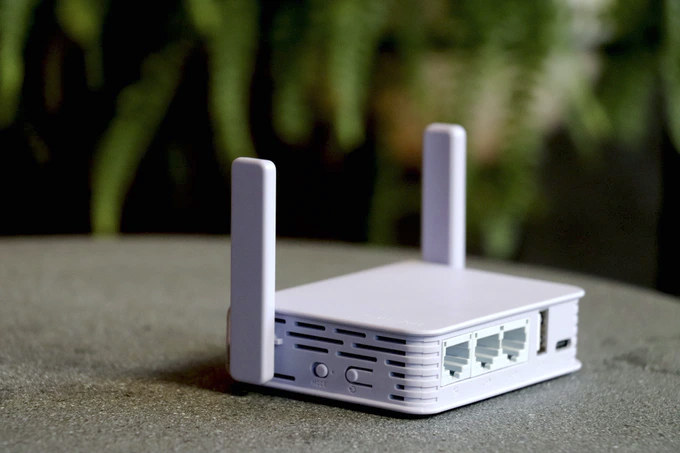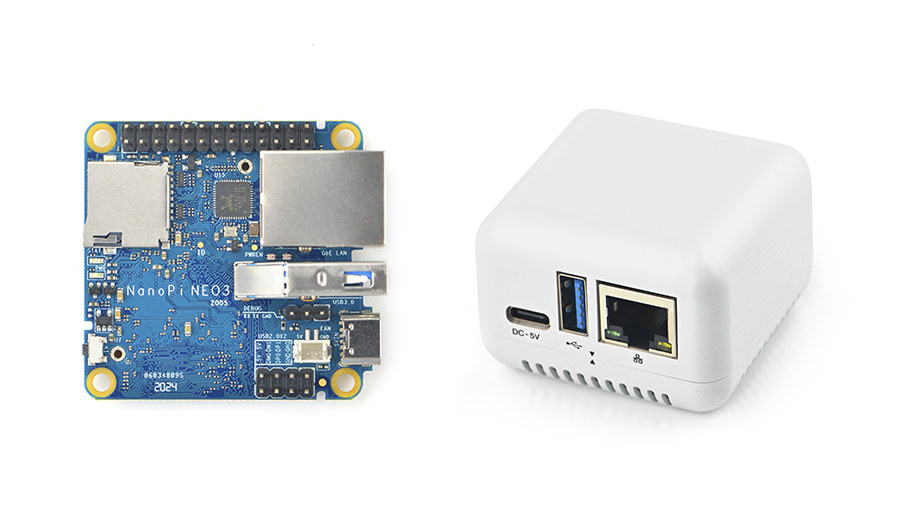Earlier this year we wrote about Wallys Communications DR6018-V2 WiFi 6 embedded router board based on Qualcomm IPQ6010 processor with M.2 sockets for optional 5G and WiFi 6E cards. The company has now launched a more compact, and cheaper board with DR6018-S SBC based on the same processor with 802.11ax WiFi 6 and 802.11 b/g/n/ac WiFi 5 support, plus an M.2 socket for people wanting to add WiFi 6E cards. DR6018-S board specifications: SoC – Qualcomm Atheros IPQ6010 quad-core Arm Cortex-A53 processor @ 1.8 GHz System Memory – 1GB (2x 512MB) DDR3L 16-bit interface with 32-bit memory bus design Storage – 256MB NAND Flash, 32MB NOR flash, optional SD card slot Networking Wired – 2x Gigabit Ethernet port including one with PoE support Wireless WiFi 2×2 2.4GHz MU-MIMO OFDMA 802.11b/g/n/ax WiFi 6, max 23dBm per chain 2×2 5GHz MU-MIMO OFDMA 802.11a/n/ac/ax WiFi 6, max 20dBm per chain 4x u.FL connectors […]
NanoPi R4S SBC launched with optional metal case for $45 and up
We found NanoPi R4S board in a work-in-progress Wiki last month. The tiny single board computer is designed for headless applications but comes with much better specifications compared to similar boards with a Rockchip RK3399 hexa-core processor with up to 4GB RAM, dual Gigabit Ethernet, and USB 3.0 ports. At the time we had limited information, but FriendlyELEC has now started selling the board for $45 and up, together with an optional metal case for a fanless operation that should ensure very good cooling. Here’s a reminder of NanoPi R4S specifications: SoC – Rockchip RK3399 hexa-core processor with dual-Core Cortex-A72 up to 2.0GHz, quad-core Cortex-A53 up to 1.5GHz, Mali-T864 GPU with OpenGL ES1.1/2.0/3.0/3.1, OpenCL, DX11, and AFBC support, 4K VP9 and 4K 10-bit H265/H264 60fps video decoder System Memory – 1GB DDR3 or 4GB LPDDR4 Storage – MicroSD card slot Networking – 2x GbE, including one native Gigabit Ethernet, and […]
Cellular gateway board takes up to five 4G mini PCIe cards, one 5G M.2 module, seven SIM cards
One Banana Pi customer asked them to customize Banana Pi BPI-R64 Linux router board based on MediaTek MT7622 WiFi processor as part of their “BPI 4.0 server” OEM/ODM customization service. Specifically, they were asked to design a cellular gateway board with the same five Gigabit Ethernet ports as on the original board, but adding five mini PCIe sockets and SIM card slots for 3G/4G cards, and one M.2 socket plus two SIM cards for a 5G module. Here’s the result! Banana Pi “GrassRouter” cellular gateway board specifications: SoC – MediaTek MT7622E dual-core ARM Cortex-A53 processor @ 1.35GHz System Memory – 1 or 2GB RAM Storage – 8GB eMMC flash, MicroSD card slot Connectivity Cellular 1x 5G via M.2 Key-B module (USB 3.0 or PCIe bus), 2x SIM card slots. Up to 5x 3G/4G LTE via mPCIe expansion socket, 5x SIM card slots Ethernet – 5x Gigabit Ethernet ports (4x LAN […]
Traverse Ten64 eight-core ARM64 10GbE networking platform runs mainline Linux (Crowdfunding)
Traverse Ten64 is a networking platform designed for 4G/5G gateways, local edge gateways for cloud architectures, IoT gateways, and network-attached-storage (NAS) devices for home and office use. Ten64 system runs Linux mainline on based NXP Layerscape LS1088A octa-core Cortex-A53 communication processor with ECC memory support, and offers eight Gigabit Ethernet ports, two 10GbE SFP+ cages, as well as mini PCIe and M.2 expansion sockets. Traverse Ten64 hardware specifications: SoC – NXP QorIQ LS1088 octa-core Cortex-A53 processor @ 1.6 GHz, 64-bit with virtualization, crypto, and IOMMU support System Memory – 4GB to 32GB DDR4 SO-DIMMs (including ECC) at 2100 MT/s Storage 8 MB onboard QSPI NOR flash 256 MB onboard NAND flash NVMe SSDs via M.2 Key M microSD socket multiplexed with SIM2 Networking 8x 1000Base-T Gigabit Ethernet ports (RJ45) 2x 10GbE SFP+ cages Optional wireless M.2/mPCIe card plus 3-choose-2 nanoSIM/microSD socket and up to 11x SMA connectors for antennas USB […]
DR6018 V2 Embedded WiFi 6 Router Board Adds Support for WiFi 6E and 5G IoT M.2 Cards
A few months ago we covered DR6018 (aka CP01) WiFi 6 Embedded SBC powered by Qualcomm IPQ6018 processor and offering six Ethernet ports including five Gigabit interfaces and one 2.5 Gbps Ethernet port. Wallys Communications has now informed CNX Software they had a new version of the board called DR6018 V2 with a more compact form factor, support for PoE, as well as optional WiFi 6E and 5G IoT M.2 modules. DR6018 V2 board specifications: SoC – Qualcomm Atheros IPQ6010 quad-core Arm Cortex-A53 processor @ 1.8 GHz System Memory – 1GB (2x 512MB) DDR3L 16-bit interface with 32-bit memory bus design Storage – 256MB NAND Flash, 32MB NOR flash, SD card slot Networking Wired 3x Gigabit Ethernet ports (one less compared to DR6018) 1x Gigabit Ethernet port with PoE support 1x 2.5Gbps Ethernet port Wireless WiFi 2×2 2.4GHz MU-MIMO OFDMA 802.11b/g/n/ax WiFi 6, max 23dBm per chain 2×2 5GHz MU-MIMO […]
Rock Pi E SBC Comes with WiFi, Bluetooth, Two Ethernet Ports, and Optional PoE
Radxa has launched several Rockchip boards from the higher-end Rock Pi N10 (RK3399Pro) and Rock Pi 4 (RK3399) SBC’s, to the low-end and tiny Rock Pi S powered by an RK3308 Cortex-A35 processor. The company has now launched Rock Pi E single board computer equipped with the popular Rockchip RK3328 quad-core Cortex-A53 processor and designed for router & gateway application with two Ethernet ports, WiFi, and Bluetooth. Power-over-Ethernet (PoE) also comes as an option. Rock Pi E specifications: SoC – Rockchip RK3328 quad-core Arm Cortex-A53 processor @ up to 1.3 GHz System Memory – 256MB, 512MB, 1GB, or 2GB DDR3 Storage – MicroSD card slot up to 128GB, eMMC module support ( 16GB / 32GB / 64GB / 128GB) Video & Audio – 3.5mm AV output jack (Not 100% sure whether composite video is supported) Connectivity 1x Gigabit Ethernet port with PoE support via an additional HAT 10/100M Ethernet Wireless […]
Brume-W Pocket-Sized Wireless Gateway Runs OpenWrt or Ubuntu (Crowdfunding)
GL.iNet Brume-W (GL-MV1000W) is a “pocket-sized wireless gateway for edge computing” that supports high-speed VPN up to 280Mbps with WireGuard, AdGuard ad-blocking software (AdGuard), and Tor. The device features three Gigabit Ethernet ports and built-in 2.4 GHz WiFi 4 connectivity, but it also supports Alfa AWUS036AC and AWUS036ACS USB WiFf USB dongles for users wanting dual-band WiFi 5 (AC) networking. The router ships with OpenWrt pre-installed, but also supports Ubuntu. Brume-W specifications: SoC – Marvell ARMADA 88F3720 (aka ARMADA 3720) dual-core Cortex-A53 processor @ 1.0 GHz with packet processor/network accelerator System Memory – 1GB DDR4 Storage – 16MB NOR flash and 8GB eMMC flash, MicroSD card slot up to 256GB Connectivity 3x Gigabit Ethernet ports (1x WAN + 2x LAN) Built-in 2.4 GHz 802.11b/g/n WiFi 4 up to 300 Mbps with external WiFi antennas Support for external 802.11ac WiFI 5 USB dongles USB – 1x USB host port, 1x USB-C […]
NanoPi NEO3 Headless SBC Launched for $20 and up
Last month, we found out FriendlyELEC was working on NanoPi NEO3, a tiny SBC powered by Rockchip RK3328 processor and made for headless applications and networked storage thanks to Gigabit Ethernet and USB 3.0 ports, as well as a 26-pin GPIO header. At the time, the board was still been finalized, but the company has now started to take orders for $20 and up depending on options which include a cute white enclosure.. Here’s a quick reminder of NanoPi NEO3 specifications: SoC – Rockchip RK3328 quad-core Arm Cortex A53 processor with Mali-450MP2 GPU System Memory – 1GB or 2GB DDR4 Storage – MicroSD Slot for system boot and storage Video Output – N/A Connectivity – Gigabit Ethernet with unique MAC via RTL8211E PHY USB – 1x USB3.0 Type-A port, 2x USB2.0 on 2.54mm 8-pin header Expansion – 26-pin header with I2C, UART, SPI, I2S, GPIO Debugging – 3-pin header for […]


